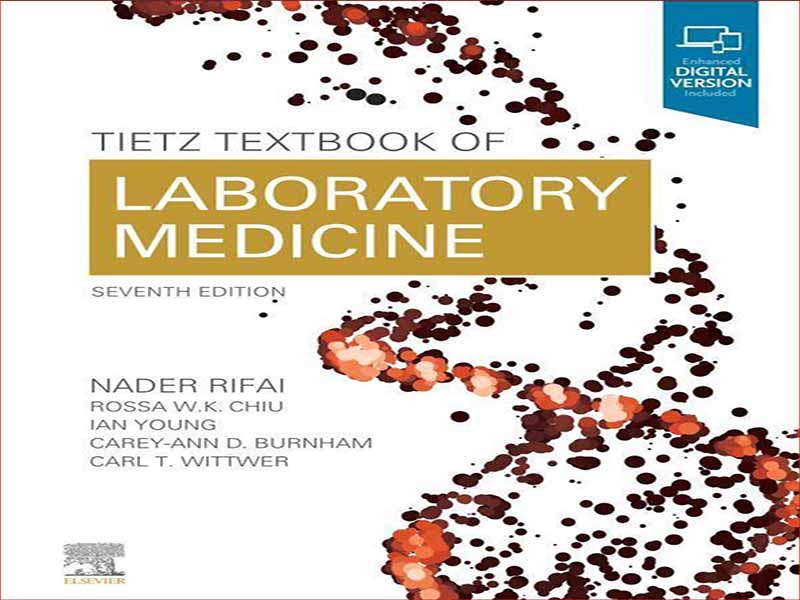- عنوان کتاب: LABORATORY MEDICINE
- نویسنده: NADER RIFAI
- حوزه: پزشکی آزمایشگاهی
- سال انتشار: 2023
- تعداد صفحه: 4225
- زبان اصلی: انگلیسی
- نوع فایل: pdf
- حجم فایل: 114 مگابایت
پزشکی آزمایشگاهی یک رشته گسترده و ناهمگن است که با اندازه گیری بیومارکرهای شیمیایی، بیوشیمیایی، سلولی و ژنتیکی سروکار دارد. این رشته شامل رشته های متعددی از جمله شیمی بالینی، هماتولوژی و انعقاد، میکروبیولوژی بالینی (از جمله سرولوژی و ویروس شناسی)، ایمونولوژی بالینی، تشخیص مولکولی، و در برخی از کشورها، پزشکی انتقال خون است. آسیب شناسی بافت و سیتولوژی، اگرچه بخشی از تعریف گسترده پزشکی آزمایشگاهی است که شامل تمام آزمایشات بافت انسانی است، اما در این کتاب درسی گنجانده نشده است. اگرچه زمینههای مختلف پزشکی آزمایشگاهی در یک تکامل پویا پیوسته همپوشانی دارند، رشتههای خاص تصاویر متفاوتی را استخراج میکنند. برای شیمی بالینی، به اندازه گیری pH یا آنالایزرهای شیمی بزرگ فکر می کنیم. برای هماتولوژی یا میکروبیولوژی، آزمایش میکروسکوپی اولین چیزی است که به ذهن می رسد. و تشخیص مولکولی پروژه ژنوم انسان، تشخیص همراه، و پزشکی شخصی و دقیق را تداعی می کند. در حالی که شیمی بالینی و تشخیص مولکولی به شدت به پیشرفتهای فناوری وابسته هستند، جایی که اولی در آزمایش دسترسی تصادفی برتری دارد و دومی روشهای موازی زیادی را تکامل داده است، عمل انتقال خون و هماتولوژی کاملاً بالینی است. علاوه بر این، رشته های خاصی مانند پزشکی انتقال خون به خوبی تعریف شده و به طور مداوم در سطح بین المللی انجام می شود، در حالی که سایر رشته ها مانند شیمی بالینی و میکروبیولوژی بالینی ممکن است بسته به کشوری که در آن انجام می شود، از نظر محتوا متفاوت باشند. طبق تعریف فدراسیون بینالمللی شیمی بالینی و پزشکی آزمایشگاهی (IFCC)، «شیمی بالینی بزرگترین زیرشاخه پزشکی آزمایشگاهی است که یک تخصص پزشکی و علمی چند رشتهای با چندین زیررشته متقابل مانند هماتولوژی، ایمونولوژی، بیوشیمی بالینی است. و دیگران. از طریق این فعالیتها، شیمیدانان بالینی بر روی عمل پزشکی به نفع عموم تأثیر میگذارند.»1 بخشهای پزشکی آزمایشگاهی بیمارستانی و آزمایشگاههای بالینی تجاری آزمایشهای آزمایشگاهی انواع نشانگرهای زیستی در مایعات یا بافتهای مختلف بدن انسان را برای غربالگری ارائه میکنند. یک بیماری، تایید یا حذف یک تشخیص، کمک به انتخاب یا نظارت بر درمان، یا ارزیابی پیش آگهی. این ادعای رایج که 60 تا 70 درصد تصمیمات بالینی مبتنی بر آزمایشات آزمایشگاهی است را نمی توان به راحتی با داده های اندازه گیری شده به طور عینی توجیه کرد.
Laboratory medicine is a broad and heterogeneous field that deals with the measurement of chemical, biochemical, cellular, and genetic biomarkers; it encompasses multiple disciplines including clinical chemistry, hematology and coagulation, clinical microbiology (including serology and virology), clinical immunology, molecular diagnostics, and, in certain countries, transfusion medicine. Tissue pathology and cytology, although part of the broad definition of laboratory medicine that includes all testing of human tissue, are not included in this textbook. Although the various fields of laboratory medicine overlap in a continuous dynamic evolution, specific disciplines elicit different images. For clinical chemistry, one thinks of pH measurements or large chemistry analyzers; for hematology or microbiology, microscopic examination is what first comes to mind; and molecular diagnostics conjures up the human genome project, companion diagnostics, and personalized and precision medicine. Whereas clinical chemistry and molecular diagnostics are heavily dependent on technological developments, where the former excels in random access testing and the latter has evolved massively parallel methods, the practice of transfusion medicine and hematology is decidedly clinical. Furthermore, certain disciplines like transfusion medicine are well defined and consistently practiced internationally, while others such as clinical chemistry and clinical microbiology may vary in content depending on the country in which they are practiced. According to the definition of the International Federation of Clinical Chemistry and Laboratory Medicine (IFCC), “Clinical Chemistry is the largest subdiscipline of Laboratory Medicine which is a multidisciplinary medical and scientific specialty with several interacting subdisciplines, such as hematology, immunology, clinical biochemistry, and others. Through these activities clinical chemists influence the practice of medicine for the benefit of the public.”1 Hospital-based laboratory medicine departments and commercial clinical laboratories provide in vitro testing of a variety of biomarkers in various fluids or tissues of the human body to screen for a disease, confirm or exclude a diagnosis, help to select or monitor a treatment, or assess prognosis. The popular claim that 60 to 70% of clinical decisions are based on laboratory tests cannot be easily justified by objectively measured data.2,3 Nevertheless, laboratory testing impacts healthcare delivery to virtually every patient.
این کتاب را میتوانید بصورت رایگان از لینک زیر دانلود نمایید.
Download: LABORATORY MEDICINE


































نظرات کاربران